Curating the Oceans: The Future of Singapore's Past
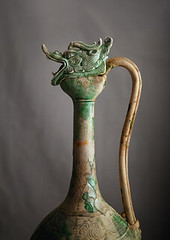 The Gaspar Strait runs between the Indonesian islands of Bangka and Belitung, some 300 miles southeast of Singapore, where I sit today, writing these words. Its calm, blue surface belies the snarl of rocks and reefs beneath, and the so-called Belitung Wreck is just one of many ships that met its demise in these perilous waters. In 1998, a German prospector by the name of Tilman Walterfang dove into the strait and struck gold: or rather, some gold, silver, and lots of pots. Over the year, his prospecting company pulled 60,000 handmade artifacts out of the heavily silted waters in the Gaspar, from the wreck of a large ship that we now know sunk sometime in the ninth century. Its contents, known vaguely as ‘the Tang treasure’, have been said to enlarge forever the boundaries of our knowledge of Chinese Tang dynasty maritime history and of the nature and dimensions of early Asian trade. For the next six years or so, the treasure languished in a New Zealand warehouse, while Qatar, Shanghai, Singapore and private collectors all vied vigorously for ownership. In 2005, Singapore bought the lot. And this afternoon, I had the good fortune to be taken for a private tour of it.
The Gaspar Strait runs between the Indonesian islands of Bangka and Belitung, some 300 miles southeast of Singapore, where I sit today, writing these words. Its calm, blue surface belies the snarl of rocks and reefs beneath, and the so-called Belitung Wreck is just one of many ships that met its demise in these perilous waters. In 1998, a German prospector by the name of Tilman Walterfang dove into the strait and struck gold: or rather, some gold, silver, and lots of pots. Over the year, his prospecting company pulled 60,000 handmade artifacts out of the heavily silted waters in the Gaspar, from the wreck of a large ship that we now know sunk sometime in the ninth century. Its contents, known vaguely as ‘the Tang treasure’, have been said to enlarge forever the boundaries of our knowledge of Chinese Tang dynasty maritime history and of the nature and dimensions of early Asian trade. For the next six years or so, the treasure languished in a New Zealand warehouse, while Qatar, Shanghai, Singapore and private collectors all vied vigorously for ownership. In 2005, Singapore bought the lot. And this afternoon, I had the good fortune to be taken for a private tour of it.Junks and their junk
The vessel that sunk was likely a dhow of Arab or Indian origin, a conjecture substantiated well by Michael Flecker, an archaeologist who was invited by Tilman Walterfang himself to direct and document the excavation. (Some of Flecker’s academic papers on the topic, as well as a fascinating but brief clip of part of the excavation, can be found here). According to Flecker, one of the most striking features of the dhow is that it was not held together with nails or dowels, but sewn together, likely with coconut-husk fibers. Its probable destination is also well established. In the world of the ninth century, dominated economically by two imperial giants — Tang Dynasty China and Abbasid Persia — the ship has been reasonably thought to be sailing from one to the other, probably from Guangzhou to Basra. The vessel is purported to be the first of Middle Eastern origin found in Southeast Asian waters.
Singapore, alas, didn’t acquire the actual ship, so I didn’t get to see it. We saw the Tang treasure instead. At present, most of it is housed in an unassuming basement at the bottom of the Hua Song Museum in Singapore. The place looked to me, as I walked in this evening, a little like a bomb shelter.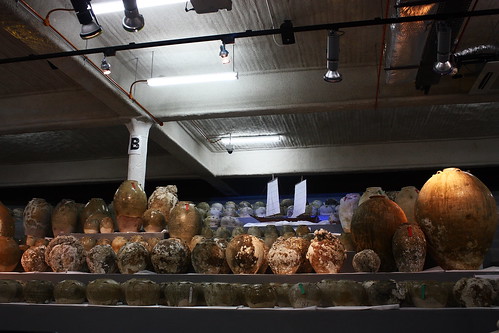
What strikes you almost as soon as you walk into the warehouse is the sheer scale of production. It seems that China then, as now, was mass producing and exporting their goods in staggering quantities — several centuries earlier than scholars have previously thought. You might say that in the hold of this sunken ship lurked, for 1200 years, a kind of ancient Ikea.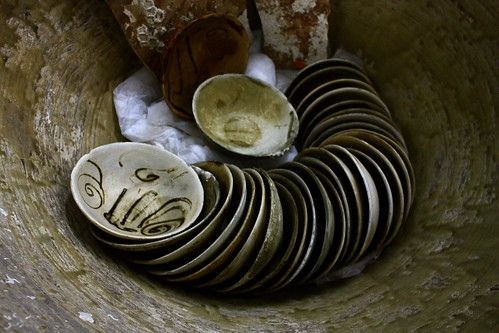
The serial nature of most of the cargo, and the fact that the ceramics exhibit styles distinct to at least five different kilns from all over China, both seem to suggest that this was an export vessel. Of particular interest is the enormous quantity of mint-condition Changsha pottery, a form of Southern Tang ceramic readily identified by its distinctive brown and straw-coloured glaze.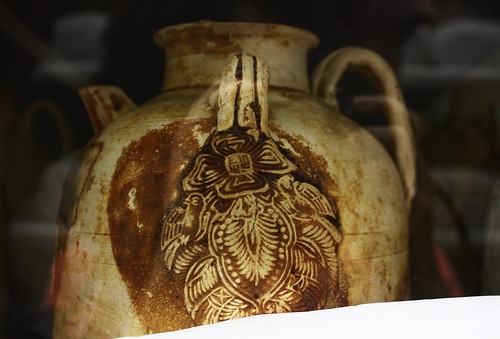
The Changsha specimens found in the Belitung wreck are decorated with an enormous range of motifs. There is something for everyone: lotuses, makara fish and Chinese calligraphy for the Buddhists, invocations of Allah and non-pictorial, geometric patterns for the Muslims, and everything in between. These are not terribly valuable in and of themselves; they are, as Simon Worrall’s droll appraisal in his article in National Geographic goes, “the Tang equivalent of Fiestaware”.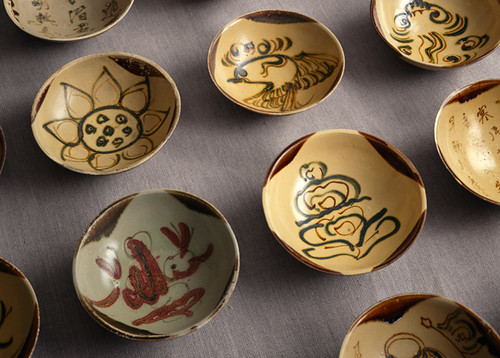
This photo by Tony Law, National Geographic
But there were a few big fish amidst these plebeian offerings: articles so valuable that they are kept elsewhere, under armed guard. These were artifacts found in the stern of the ship: a small clutch of exquisite, royal-grade items, valuable not only in dollar terms, or for their exquisite craftsmanship, but in terms of their historical import. They include a fine octagonal-shaped gold cup — the largest Tang dynasty gold cup ever found, featuring Persian-looking men and women embossed on each face — and three incredibly rare, perfectly preserved specimens of pre-Yuan blue and white porcelain.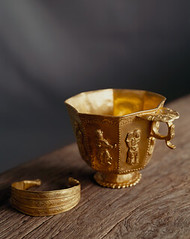
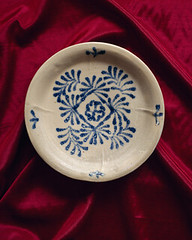
These photos by Tony Law, National Geographic
The latter is a particularly interesting testament to the cross-cultural fertilization that characterizes Silk Road histories. Cobalt oxide was almost certainly brought to China by Arab traders; the ore from which it is made can only be found in West Asia, and particularly in Persia. When Arab traders brought cobalt oxide into Guangzhou and began commissioning blue and white ceramics from China, they set into motion the process by which China began to create porcelain that would, over the course of the next five centuries, become so iconic that they came forever to bear China’s name. The story of cobalt oxide is quite well known amongst scholars, but the Jingdezhen blue-and-whites only really began to take off in the late Yuan period. These three small plates, from a ship wrecked in the ninth century, disclose a longer, deeper history.
My personal favourites, however, were the most plebeian offerings of all: those artifacts encrusted with barnacles and corals. In the whole collection, they stood out to me like elegant anomalies, mute witnesses of a millennia of submergence, and utterly beautiful.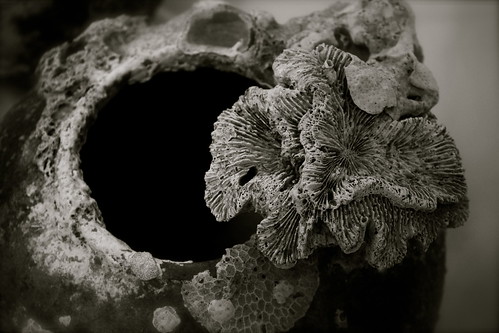
Undercurrents
Just like the waters of the Gaspar Strait, there too are hidden currents to the Belitung Wreck. For one thing, it came to Singaporean hands amidst a maelstrom of legal wrangling. In 2004, Tilman Walterfang became entangled in a court case when his own marketing agent, Baron Nicolai von Uexkull, took him to court for defaulting on the payment of his (the Baron’s) salary and commission, for the work of negotiating the sale of the treasure. In 2005, not long after the treasure was finally sold to Singapore’s Sentosa Leisure Group following months of negotiation, it emerged that the good Baron had, in his earlier negotiations with Singapore, allegedly disclosed price-sensitive information to the buyers. Walterfang then sued Von Uexkull in 2006 for breach of confidentiality.
As if that weren’t enough: in the course of the sale, Walterfang also became embroiled in a controversy with the Indonesian government, who accused him of failing to pay them the fair share of the proceeds from the treasure. 53,000 pieces of the Tang treasure were sold to Singapore for some US$32 million. Under Indonesian conservation law, the state government is entitled to half of this, but it appears that only US$2.5 million or so ever made it into Indonesian coffers. The Indonesians are, naturally, highly displeased, and it seems unclear how Walterfang managed to get away with this. There have been, unsurprisingly, allegations of bribery.
But the most interesting hidden current, for me, is the way in which a find like this slowly gets shaped into history. Curators and creative minds at the Singapore Maritime Heritage Foundation, which was brought into existence for the purpose of administering the treasure, are right now groping for a Grand Story, a narrative into which the Tang treasure can fit. In particular, there’s talk of a great Maritime Silk Route Museum to be built in Singapore to house and exhibit these wares. Its story will no doubt vaunt Singapore’s central place at the elbow of a great oceanic route that ran parallel to the overland Silk Road. Its objectives will no doubt be to inscribe Singapore into a wider and more ancient world history, and to give historical credence to a position that is crucial to Singapore’s self-image today: as a global, maritime entrepot, and the lodestone on which Southeast Asia turns.
Counterfactual thinking here might be illuminating. What if Qatar, or Shanghai, had been successful in the bid? What if, amidst all that legal wrangling, Singapore had been jostled out of the buy, or if the Indonesian government had somehow got their act together, claimed the wreck and written it into a narrative demonstrating the magnificence and global reach of the great Srivijaya Empire, instead? What stories would be spun then, out of these fragments we shore up against our ruins? When you visit Singapore one day in not-too-distant years to come, and your Lonely Planet guidebook exhorts you to visit the brand new Maritime History Museum of Singapore, it will be beautifully done, stimulatingly presented. But remember this: none of it was set in stone. We sculpt our own stones, and we call that process history.